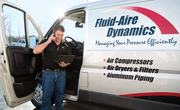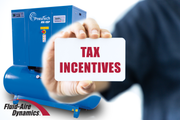Regulating the pressure of compressed air at the point of use can be important to protect pneumatic equipment and ensure the safety and efficiency of your operations. Luckily, a compressed air regulator allows you to control the pressure of air going into your air-powered equipment.
But how do you adjust PSI on air compressors? Use this guide to find everything you need to know about air compressor regulators.
What Is an Air Compressor Regulator?
The air compressor regulator is, as its name implies, a device that regulates pressure per square inch (PSI) for your compressed air needs. It controls airflow from the compressor to ensure that air used for tools and processes is delivered at a constant pressure. It also allows you to adjust the pressure manually within certain parameters.

Without this control function, you would not be able to regulate the pressure or intensity of the airflow coming from the compressor tank and going into your tools. The regulator protects each tool from being over- or under-powered and, in doing so, helps ensure the quality of your pneumatic applications. Improper pressure levels can cause tool inefficiency or even damage or destroy your tools.
Air compressor regulators may have a single pressure regulator at the exhaust outlet for your compressor or individual pressure regulators for each drop or tool. The pressure regulator allows you to precisely adjust the pressure of air going into specific tools and applications. It maintains a constant output pressure regardless of any variation in input air pressure or downstream flow requirements. The pressure regulator helps to avoid the problem of overpressurization, which wastes energy and increases the CFM requirements for the air compressor.
When you regulate your air compressor, you can reduce the amount of energy required to run your air-powered operations. Without a pressure regulator, you could consume high volumes of energy throughout each working day to meet peak demands, even if only a small fraction of your applications require this much energy. Save your business's energy and money by using a proper air compressor regulator.
How Does a Pressure Regulator Work?

A pressure regulator is essentially a control valve that allows you to increase or decrease the airflow based on your needs with a given application. Pressure regulators are designed to dampen pulses in PSI as your air compressor cycles on and off. Air compressor regulators consist of a gauge that displays the PSI, an adjustable valve that controls airflow, and a dial or knob that allows for manual airflow adjustments. The regulator typically will have an internal spring that tightens or loosens a seal, allowing more or less air to go through the regulator. When airflow is reduced, pressure is also reduced for anything downstream of the regulator.
A pressure regulator may be either direct, as described above, or pilot operated. Pilot-operated regulators — both internal and external — do not have a spring to overcome. Additionally, pilot-operated regulators are more accurate and also hold the pressure to a tighter band.
It is important to note that pressure regulators can only decrease pressure from the air compressor — they cannot increase the pressure above the PSI produced by the compressor.
As a result, the pressure regulator may be either relieving or non-relieving:
- Relieving pressure regulator: A relieving pressure regulator releases excess air into the atmosphere to relieve downstream pressure. This allows the regulator to lower the pressure delivered by the compressor, even in dead-end runs. You'll notice a loud hissing sound as excess air is released.
- Non-relieving pressure regulator: A non-relieving pressure regulator does not vent the excess air. A downstream valve is required to release the excess pressure.
Types of Pressure Regulators
Pressure regulators can be broken down even further from relieving and non-relieving. Some of the specific types of pressure regulators include:

- Poppet-style valved regulator: This regulator type is non-relieving, and it is one of the simplest and cheapest options available. It consists of a poppet-style valve controlled by an adjustment spring. The poppet controls the flow, which throttles the orifice plate to control the flow of air.
- Diaphragm chamber regulator: Bigger and more expensive than poppet-style regulators, diaphragm chamber regulators have improved sensitivity and responsiveness. This type of regulator also incorporates a separate diaphragm chamber with an aspirator tube that controls pressure within the chamber. This allows diaphragm chamber regulators to minimize pressure drop across the valve.
- Balance poppet regulator: Similar to the diaphragm chamber regulator, balance poppet regulators are also pressure-balanced to improve response and sensitivity. Balance poppet regulators have a larger orifice than diaphragm chambers, which allows for greater airflow.
- Precision pressure regulator: Precision pressure regulators contain several separate diaphragms. However, these regulators may have limited flow capacity and smaller connection ports.
Which type of pressure regulator will work best for you and your business can vary depending on your needs and budget. Some questions to consider when analyzing your various options include the following:
- How much flow capacity is needed?
- How much precision in pressure regulation is required for my application?
- Is a relieving or non-relieving pressure regulator better for my application?
- Is it important that the pressure regulator be tamper-proof?
- Do I need a pressure regulator that can be adjusted without tools?

Choosing the right air pressure regulator is crucial. If you're still not sure of the model that is right for your operational needs, our Fluid-Aire Dynamics team can help you design the optimal system for your facility.
How to Read a Pressure Gauge
Reading your compressed air pressure gauge is as simple as reading a temperature gauge or a car speedometer. Air compressor gauges have hash marks or small lines that indicate varying increments of pressure. As the pressure changes, the needle moves to show the change. The tip of the needle points to the pressure level for the compressor.
The settings on a pressure regulator are supposed to be set to the pounds per square inch (PSI) number of a corresponding tool. The PSI readings on the pressure gauge of an air compressor will generally range from 0 to 250.
Some pressure gauges can be slightly different than others. So, before you start reading your gauge, make sure to identify the following:
- Gauge pressure units: Determine the units your pressure gauge uses and the difference between each numerically marked unit. For example, your gauge may show measurements for 0, 100 and 200 PSI, which means there is a 100 PSI difference between each major unit.
- Hash mark units: Count the spaces between the marked units to figure out how many PSI units each space represents. If the example gauge has 10 spaces, then each space represents 10 units.

While it's easy to read your PSI gauge, you should make sure you study all gauges before you start using them so you can quickly note the pressure while your compressor is working. This strategy can save you a lot of time and stress in the future by helping you understand every part of your compressor from the moment you set it up.
Tank Pressure vs. Regulated Pressure
Typical industrial air compressors have two pressure gauges with needles that display the PSI levels of the two key stages in the pressurization process. Overall, these two gauges allow users to differentiate the regulation of air pressure being sent to the tank from the pressurization that is actually occurring inside the tank.
The first of these gauges, on the left-hand side, is the regulator air gauge. The regulator air gauge reads the amount of pressure reserved for the tank. The second gauge, which is on the right, is called the tank air gauge. It shows the amount of pressure generated within the tank.

So what do the two different air compressor gauges mean, and why do air compressors have two gauges? The two gauges of an air compressor are essential for a few reasons. Each gauge lets you know if the system is healthy and helps you determine flow rates and how energy gets generated inside the tank for use as air power.
A weak left gauge pressure reading indicates that the compressor cannot pressurize the air to a sufficient level for your end-point applications. Consequently, you will not see a favorable reading on the right gauge. Ideally, after identifying these weak readings, you can use an air compressor regulator according to the needs of your pneumatic applications and have the compressor generate the required level of air pressure.
For the readings to be favorable on the right gauge, you also need a healthy set of internal factors within the air compressor. In a rotary screw compressor, you need an airtight, rust-free pair of rotors that can rotate adequately. In a reciprocating compressor, you need airtight, rust-free pressurization chambers, and the piston must operate at the proper speed. If moving metal parts receive insufficient lubrication, corrosive friction will result. If condensation occurs within the compressor, rust could take root and eat its way through various metal parts.
A machine that reads favorably on both PSI gauges will generally be in a ventilated room with relatively cool, clean air. The room should be free of humidity, which makes it more difficult for air to pressurize. Even though most air compressors feature water and oil separators, these components can swiftly become hampered if too much moisture or oily mist enters the machine. The real objective is to keep moisture and dirt levels as low as possible within the ambient air, so the filters and separators can extract what remains of those elements within a healthy ambient setting.
How to Adjust Your Air Compressor Regulator
Knowing how to adjust an air compressor pressure regulator is crucial for safely and effectively operating these mechanisms. Each time you attach a different pneumatic tool to your air compressor, you might need to alter the pressure to meet the PSI requirements of the tool in question.
Use the following steps to learn more about adjusting your air compressor regulator. However, remember that air compressor models can vary — some may adjust pressure through a simple knob or dial, while others may use a digital human-machine interface (HMI). It's always best to review your owner's manual for model-specific instructions before trying to adjust your air compressor regulator.

1. Power on the Air Compressor
To make an accurate adjustment of the pressure gauge, you will first need to power on the machine and get it warmed up for a normal operating cycle. Give the tank several minutes to fill up with newly pressurized air. It is important to have a full tank of air for this adjustment routine. The noise emitted from the compressor after you turn on the power should indicate whether the initial air pressurization is successful.
2. Check the Tool for PSI Compatibility
Once you have the activated tank sufficiently full of air, check the PSI on the pneumatic tool you've set aside for this test. The tool you use must be compatible with the compressor. If the tool's PSI requirement exceeds the capacity of the compressor, avoid using that tool for this test and reserve it for a different air compressor with a higher capacity. You'll know you've found a good tool to use when the compressor pressure exceeds the requirements of the tool at hand. Once you've identified a compatible tool, you can carry on with the test.
3. Connect the Tool and Air Hose
Attach the pneumatic tool to an air hose and then attach that hose to the air compressor. If you are connecting this tool for the first time, look for the port on the instrument. If you cannot pinpoint this feature, consult the user's manual to find the port.
4. Adjust the Pressure Regulator
Once you secure the tool and hose connections, adjust the settings on the pressure regulator to match the PSI requirements specified on the tool. On most compressors, there is a knob located on the right-hand side of the pressure regulator. On certain compressors, however, the knob might be located in a different area of the machine. In the latter case, consult the user's manual to pinpoint the knob of the pressure regulator.
5. Unlock the Regulator Knob
On most regulator knobs, there will be a locking feature that you will need to release to turn the knob. In most cases, the lock is push-pull activated. To release the knob from its locked position, pull it outward. To re-lock the knob, push it back inward. If this doesn't do the trick, consult the user's manual for information on the regulator lock on your compressor.
6. Adjust the Pressure Up or Down
To intensify or increase the compressor's air pressure, turn the regulator knob clockwise. You should notice this increase in pressure fairly quickly. The monitor readings should indicate a pressure change, and you should hear the sound of the machine. Once you bring the regulator to the desired pressure, push the knob back in to lock that setting in place.
If you need to decrease the pressure, turn the regulator knob counterclockwise until the pressure is lowered to the desired level. Then ensure you return the knob back to its locked position.
When increasing or decreasing pressure, make sure to do it slowly and keep a close eye on the pressure gauge. Also, remember you can not exceed your air compressor's PSI maximum. Additionally, make sure you do not adjust PSI below the minimum ratings for your tools and equipment to prevent costly damage or operating failures.
What Happens if You Don't Adjust the Pressure Regulator?

Failure to monitor the settings on the pressure regulator could leave your air tools subjected to the wrong PSI. If the air pressure that passes from the machine doesn't match the PSI rating of the tool at hand, the tool will be rendered less effective and could be damaged.
Damaged equipment can be dangerous, costly to replace and impact workflow, so adjusting the pressure regulator when needed is crucial.
What PSI Do You Need for Your Air Tools?
If you're unsure of the optimal PSI to use, consult your operating manual. Different tools will have different PSI requirements for optimal operation. Your operating manual will tell you the minimum PSI rating for the tool.
How you'll use the tool can also determine the appropriate PSI. Some industries may require larger equipment and power for their industrial processes. For example, applications like air drying, sanding and painting require a more continuous supply of air pressure.
However, most pneumatic tools are designed for operation at pressures of 90 PSI. Your operating manual will probably have three ratings: the recommended operating pressure, the minimum operating pressure and the maximum operating pressure. If pressure drops below the minimum, the tool will not operate correctly and may stop functioning entirely. Operating above the maximum pressure will cause excess wear and tear on the equipment and could result in costly damage. As long as pressure does not drop below the minimum, there is no added benefit to operating the tool at a higher PSI than required.
A general-purpose pressure regulator will maintain pressure within +/- 2 – 5 PSI. This is adequate for most pneumatic tools and general applications. Some applications have tighter pressure tolerances. A precision pressure regulator can maintain pressure within +/- 0.5 – 1.5 PSI. These regulators may have several separate diaphragms that balance each other to maintain a precise pressure. Do not size regulators by pipe size. Instead, size by CFM flow.
Learn How to Maintain Your Compressed Air System With Fluid-Aire Dynamics
When it comes to air compressors, Fluid-Aire Dynamics has all the knowledge you will ever need. We have been solving compressed air and gas tank problems for over 30 years. Plus, all of our superior system designs meet Compressed Air & Gas Institute (CAGI), Compressed Gas Association (CGA), ANSI and ASME standards, so you can feel safe and confident while operating them.
With our wide range of quality air compressors and extensive industry knowledge, our team can find the best solutions for you and your business. Industries ranging from pharmaceutical production to hospitality management can benefit from these top-of-the-line machines and our comprehensive understanding of air compressor function.
Learn more about proper compressed air system maintenance and more with our free online resources. If you still have any questions at all about air compressors, don't hesitate to contact us online or call to speak with a knowledgeable staff member. We pride ourselves on our excellent customer service, and we're eager to help you in any way we can.






